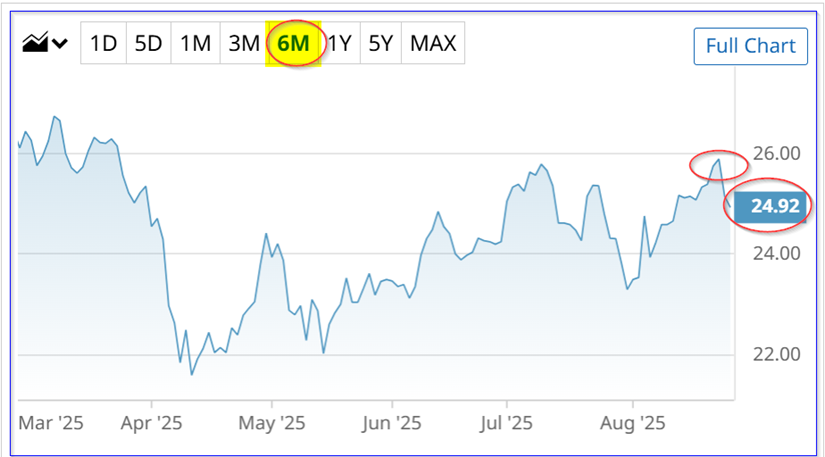/Pfizer%20Inc_%20NY%20HQ-by%20JHVEPhoto%20via%20iStock.jpg)
Barchart reports that Pfizer Inc. (PFE) stock is showing unusual put optiohttps://www.barchart.com/stocks/quotes/PFE/overviewn activity in yesterday's trading. Does that mean investors have turned bearish? Not necessarily, especially given the company's upgraded guidance.
PFE stock closed at $24.92 on Tuesday, August 26, down from a recent high of $25.88 on August 22. However, it's up from a recent trough of $23.29 on July 31. That was just before it released Q2 earnings on Aug. 5.

However, with Barchart's Unusual Stock Options Activity Report today, some may be wondering if investors have turned deeply bearish.
The Report shows that over 25,000 in-the-money (ITM) put contracts have traded for the expiry period ending Sept. 12, 2025, which is 17 days from today.

The put contracts have a strike price of $26.00, which is $1.08 higher than the closing price of $24.92, making them “in-the-money” (ITM). The premium at the midpoint is $1.15, so any investor buying these puts has a breakeven point of $26.00-$1.15, or $24.85.
That is only 7 cents lower than the trading price, so not much. It indicates that these buyers feel strongly that PFE will fall to below that breakeven by Sept. 12. However, their long investment has a good deal of intrinsic value, assuming PFE stock stays flat.
For example, if PFE closes at $24.92 on Sept. 92, the puts would still be worth $1.08 ($26-$24.92), giving them a loss of just 6.36% (i.e., $0.07/$1.15). That means they have hedged their bet that PFE will fall here quite a lot.
On the other hand, short sellers of these puts are already obligated to buy shares at $26.00. But, given the $1.15 in income they have received already, their net cost is just $24.85, or 0.28% below today's trading price.
They are hoping/betting that PFE will rise to $26.00 or higher by Sept. 12. At that point, over $26.00, they won't have an obligation to buy shares at $26.00. Their investment would have made a 4.42% yield (i.e., $1.15/$26.00) with no obligation to buy shares.
And even if it rises closer to $26.00, the put option premium will fall, and they can cover their short position with a “Buy to Close” at a profit. In effect, this is a great way to buy into PFE stock at a cheaper price.
Trading the Range
So, what is going on here? Investors may be using these puts to trade PFE in an obvious range that it has been having. That can be seen in the chart above. It shows that in the past 4 or 5 months, PFE has traded between $22 or $23 and $26.00.
The long put buyers may think that PFE is due for a tumble here, and the short sellers of the puts may think that it won't happen.
For one, the company's recent earnings report was very bullish, and management raised its guidance for revenue and earnings. They now expect to see earnings per share (EPS) to come in between $2.90 and $3.10.
That puts the stock on a very cheap forward multiple of just 8.3x at the midpoint (i.e., $24.92/$3.00 = 8.3).
Upside Potential and Target Prices
One thing is for sure. PFE stock is still deeply undervalued. I discussed this in my Aug. 12 Barchart article, “Pfizer Raises Its Guidance and Analysts Up Their Targets - PFE Stock Looks Cheap.”
I showed that PFE stock could be worth as much as $32.24, based on its average price/earnings (P/E) multiple historical values. That is +29.4% over today's price.
Moreover, using its average dividend yield of 4.65%, (it's 6.90% today, i.e., $1.72 div. per share/$24.92), PFE could be worth $36.99, or +48% more:
$1.72 / 0.0465 = $36.99, and
$36.99 / $24.92 = 1.4843 -1 = +48.43% upside
And that is before any dividend increase for next year.
Moreover, analysts have been raising their earnings projections. For example, Seeking Alpha now shows that the average EPS forecast for 2025 is $3.07, up from $3.05 in my prior article.
The average price target for analysts is $29.36 from a Stock Analysis survey, and $33.00 from AnaChart (up from $32.66 two weeks ago).
Summary
The bottom line is that PFE stock still looks cheap today. This is from a historical value standpoint and using analysts' and management's projections.
It could explain many of the reasons why there is so much unusual put options activity in these in-the-money (ITM) put options expiring in just over 2 weeks.
Investors should be careful about following these trades, however, given the risks associated with trading ITM put options. Investors can study these risks by reviewing the Barchart Options Education Center tabs.







